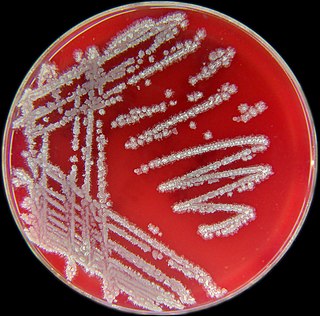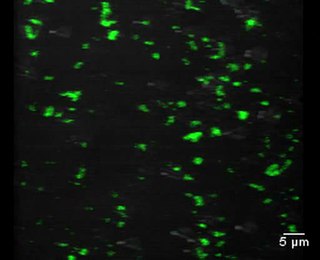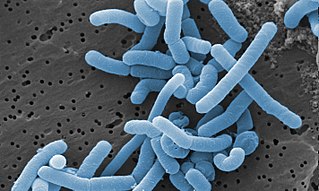Related Research Articles

Bacillus is a genus of Gram-positive, rod-shaped bacteria, a member of the phylum Bacillota, with 266 named species. The term is also used to describe the shape (rod) of certain bacteria; and the plural Bacilli is the name of the class of bacteria to which this genus belongs. Bacillus species can be either obligate aerobes: oxygen dependent; or facultative anaerobes: having the ability to continue living in the absence of oxygen. Cultured Bacillus species test positive for the enzyme catalase if oxygen has been used or is present.

Bacillus cereus is a Gram-positive, rod-shaped, facultatively anaerobic, motile, beta-hemolytic, spore-forming bacterium commonly found in soil, food and marine sponges. The specific name, cereus, meaning "waxy" in Latin, refers to the appearance of colonies grown on blood agar. Some strains are harmful to humans and cause foodborne illness, while other strains can be beneficial as probiotics for animals. The bacteria is classically contracted from fried rice dishes that have been sitting at room temperature for hours. B. cereus bacteria are facultative anaerobes, and like other members of the genus Bacillus, can produce protective endospores. Its virulence factors include phospholipase C, cereulide, sphingomyelinase, metalloproteases, and cytotoxin K.

Lactobacillus is a genus of Gram-positive, aerotolerant anaerobes or microaerophilic, rod-shaped, non-spore-forming bacteria. Until March 2020, the genus Lactobacillus comprised over 260 phylogenetically, ecologically, and metabolically diverse species; a taxonomic revision of the genus in 2020 assigned lactobacilli to 25 genera.

Probiotics are live microorganisms promoted with claims that they provide health benefits when consumed, generally by improving or restoring the gut flora. Probiotics are considered generally safe to consume, but may cause bacteria-host interactions and unwanted side effects in rare cases. There is some evidence that probiotics are beneficial for some conditions, but there is little evidence for many of the health benefits claimed for them.

Bacillus subtilis, known also as the hay bacillus or grass bacillus, is a Gram-positive, catalase-positive bacterium, found in soil and the gastrointestinal tract of ruminants, humans and marine sponges. As a member of the genus Bacillus, B. subtilis is rod-shaped, and can form a tough, protective endospore, allowing it to tolerate extreme environmental conditions. B. subtilis has historically been classified as an obligate aerobe, though evidence exists that it is a facultative anaerobe. B. subtilis is considered the best studied Gram-positive bacterium and a model organism to study bacterial chromosome replication and cell differentiation. It is one of the bacterial champions in secreted enzyme production and used on an industrial scale by biotechnology companies.

Lactobacillus acidophilus is a species of Gram-positive bacteria in the genus Lactobacillus. L. acidophilus is a homofermentative, microaerophilic species, fermenting sugars into lactic acid, and grows readily at rather low pH values and has an optimum growth temperature of around 37 °C (99 °F). L. acidophilus is found in the human and animal gastrointestinal tract and mouth. Some strains of L. acidophilus may be considered to have probiotic characteristics. These strains are commercially used in many dairy products, sometimes together with Streptococcus thermophilus and Lactobacillus delbrueckii subsp. bulgaricus in the production of acidophilus-type yogurt, or acidophiline. Its genome has been sequenced.
Lactiplantibacillus plantarum is a widespread member of the genus Lactiplantibacillus and commonly found in many fermented food products as well as anaerobic plant matter. L. plantarum was first isolated from saliva, based on its ability to temporarily persist in plants, the insect intestine and in the intestinal tract of vertebrate animals, it was designated as nomadic organism. L. plantarum is Gram positive, bacilli shaped bacterium. L. plantarum cells are rods with rounded ends, straight, generally 0.9–1.2 μm wide and 3–8 μm long, occurring singly, in pairs or in short chains. L. plantarum has one of the largest genomes known among the lactic acid bacteria and is a very flexible and versatile species. It is estimated to grow between pH 3.4 and 8.8. Lactiplantibacillus plantarum can grow in the temperature range 12 °C to 40 °C. The viable counts of the "L. plantarum" stored at refrigerated condition (4 °C) remained high, while a considerable reduction in the counts was observed stored at room temperature.

Bacillus coagulans is a lactic acid–forming bacterial species first isolated and described in 1915 by B.W. Hammer at the Iowa Agricultural Experiment Station as a cause of an outbreak of coagulation in evaporated milk packed by an Iowa condensary. Separately isolated in 1935 and described as Lactobacillus sporogenes in the fifth edition of Bergey's Manual of Systematic Bacteriology, it exhibits characteristics typical of both genera Lactobacillus and Bacillus; its taxonomic position between the families Lactobacillaceae and Bacillaceae was often debated. However, in the seventh edition of Bergey's, it was finally transferred to the genus Bacillus. DNA-based technology was used in distinguishing between the two genera of bacteria, which are morphologically similar and possess similar physiological and biochemical characteristics.
Bacillus safensis is a Gram-positive, spore-forming, and rod bacterium, originally isolated from a spacecraft in Florida and California. B. safensis could have possibly been transported to the planet Mars on spacecraft Opportunity and Spirit in 2004. There are several known strains of this bacterium, all of which belong to the Bacillota phylum of Bacteria. This bacterium also belongs to the large, pervasive genus Bacillus. B. safensis is an aerobic chemoheterotroph and is highly resistant to salt and UV radiation. B. safensis affects plant growth, since it is a powerful plant hormone producer, and it also acts as a plant growth-promoting rhizobacteria, enhancing plant growth after root colonization. Strain B. safensis JPL-MERTA-8-2 is the only bacterial strain shown to grow noticeably faster in micro-gravity environments than on the Earth surface.

Bacillus licheniformis is a bacterium commonly found in the soil. It is found on bird feathers, especially chest and back plumage, and most often in ground-dwelling birds and aquatic species.

Food microbiology is the study of the microorganisms that inhabit, create, or contaminate food. This includes the study of microorganisms causing food spoilage; pathogens that may cause disease ; microbes used to produce fermented foods such as cheese, yogurt, bread, beer, and wine; and microbes with other useful roles, such as producing probiotics.

Streptococcus thermophilus also known as Streptococcus salivarius subsp. thermophilus is a gram-positive bacterium, and a fermentative facultative anaerobe, of the viridans group. It tests negative for cytochrome, oxidase, and catalase, and positive for alpha-hemolytic activity. It is non-motile and does not form endospores. S. thermophilus is fimbriated.

Aeromonas hydrophila is a heterotrophic, Gram-negative, rod-shaped bacterium mainly found in areas with a warm climate. This bacterium can be found in fresh or brackish water. It can survive in aerobic and anaerobic environments, and can digest materials such as gelatin and hemoglobin. A. hydrophila was isolated from humans and animals in the 1950s. It is the best known of the species of Aeromonas. It is resistant to most common antibiotics and cold temperatures and is oxidase- and indole-positive. Aeromonas hydrophila also has a symbiotic relationship as gut flora inside of certain leeches, such as Hirudo medicinalis.

Saccharomyces boulardii is a tropical yeast first isolated from lychee and mangosteen fruit peel in 1923 by French scientist Henri Boulard. Although early reports claimed distinct taxonomic, metabolic, and genetic properties, S. boulardii is genetically a grouping of S. cerevisiae strains, sharing >99% genomic relatedness, giving the synonym S. cerevisiae var. boulardii.

Alkalihalobacillus clausii or its old scientific name Bacillus clausii is a rod-shaped, motile, and spore-forming bacterium that lives in the soil but is also a natural microflora of the mammalian gastriontestinal tract. It is classified as probiotic microorganism that maintains a symbiotic relationship with the host organism. It is currently being studied in relation to respiratory infections and some gastrointestinal disorders. Bacillus clausii has been found to produce antimicrobial substances that are active against gram-positive bacteria including Staphylococcus aureus, Enterococcus faecium and Clostridium difficile. It is sold as an anti-diarrhoea and under the brand name Erceflora by Sanofi.

Bifidobacterium is a genus of gram-positive, nonmotile, often branched anaerobic bacteria. They are ubiquitous inhabitants of the gastrointestinal tract though strains have been isolated from the vagina and mouth of mammals, including humans. Bifidobacteria are one of the major genera of bacteria that make up the gastrointestinal tract microbiota in mammals. Some bifidobacteria are used as probiotics.
Limosilactobacillus mucosae is a rod shaped species of lactic acid bacteria first isolated from pig intestines. It has mucus-binding activity. The species is an obligate anaerobe, catalase-negative, doesn't form spores and is non-motile. Its type strain is S32T, and has been found to be most closely related to Limosilactobacillus reuteri.

Lacticaseibacillus paracasei is a gram-positive, homofermentative species of lactic acid bacteria that are commonly used in dairy product fermentation and as probiotic cultures. Lc. paracasei is a bacterium that operates by commensalism. It is commonly found in many human habitats such as human intestinal tracts and mouths as well as sewages, silages, and previously mentioned dairy products. The name includes morphology, a rod-shaped bacterium with a width of 2.0 to 4.0μm and length of 0.8 to 1.0μm.

Lactobacillus delbrueckii subsp. bulgaricus is a bacterial subspecies traditionally isolated from European yogurts. Lactobacillus bulgaricusGLB44 differs from the rest of the L. bulgaricus strains as it was isolated from the leaves of Galanthus nivalis in Bulgaria, becoming the only known strain of this subspecies that has vegan origin available as a commercial probiotic. Probiotics are health promoting bacteria which, when consumed in adequate amounts, confer a benefit on the host, normally associated with positive effects on the digestive and immune systems, and are usually prescribed during or after antibiotic treatment to alleviate the symptoms of antibiotic-associated diarrhea. Probiotics are also associated with decreasing of the risk of traveler's diarrhea. The natural habitat of the snowdrop flower are European mountainous regions. Thus, GLB44 is capable of surviving in freezing temperatures, as the snowdrop flowers between January and May in nature, when the temperatures can fall below freezing in this region. These characteristics of its natural habitat allows for GLB44 to survive in foods that are plant based and remain unaffected when stored in refrigerator temperatures.
Bacillus aerius is a species of bacteria first isolated from cryogenic tubes used for collecting air samples from high altitudes, hence its name. Its type strain is 24KT.
References
- ↑ Brown, Amy (2014). Understanding Food: Principles and Preparation. Cengage Learning. p. 430. ISBN 9781285954493.
- ↑ Hutkins, Robert W. (2006). Microbiology and technology of fermented foods (1st ed.). Chicago, Ill.: IFT Press. p. 291. ISBN 047027624X.
- ↑ Rafter, Joseph (10 February 2009). "The effects of probiotics on colon cancer development". Nutrition Research Reviews. 17 (2): 277–84. doi: 10.1079/NRR200484 . PMID 19079931.
- ↑ Nomura, T; Tsuchiya, Y; Nashimoto, A; Yabusaki, H; Takii, Y; Nakagawa, S; Sato, N; Kanbayashi, C; Tanaka, O (Apr–May 2007). "Probiotics reduce infectious complications after pancreaticoduodenectomy". Hepato-gastroenterology. 54 (75): 661–3. PMID 17591036.